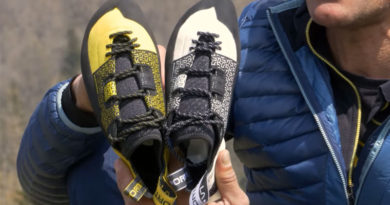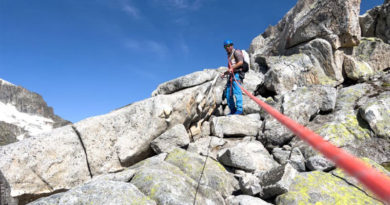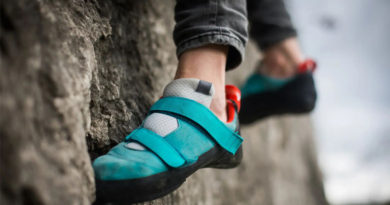Approach Shoes vs. Climbing Shoes: A Comparison
Approach shoes are designed for hiking or approaching a climbing route. They offer more support and comfort than traditional climbing shoes. They have a stiffer sole for better traction on rough terrain. These shoes often have a rubber rand for durability and abrasion resistance. Approach shoes are also more casual in appearance and can be worn as everyday shoes. This makes them useful for outdoor enthusiasts.
Climbing shoes, on the other hand, are specifically designed for climbing and offer superior performance on rock surfaces. They are typically tighter and more form-fitting than approach shoes. They offer a sticky and durable rubber sole for gripping and edging on rocks. Climbing shoes have a downturned toe and a sensitive sole. This allows you to feel the rock and apply precise pressure to small holds. They are not intended for long-distance walking or standing. However, you can use them for short bursts of intense activity on the rock.
What are Approach Shoes?
Approach shoes are made for walking or hiking up a climbing route. They are intended to be worn during the approach phase of a climb when the climber walks to the route’s base. Approach shoes provide more support and comfort than traditional climbing shoes, making them a popular choice for climbers who must hike or walk long distances to the climbing area.
They have stiffer soles than climbing shoes
Approach shoes have stiffer soles than traditional climbing shoes, which gives them more traction on rough terrain. They frequently have a rubber rand around the toe and sides of the shoe for added durability and abrasion resistance. This helps the shoe last longer by preventing wear and tear from rocks and other debris.
They are more versatile
The versatility of approach shoes is another important feature. Unlike climbing shoes, which are specifically designed for climbing, approach shoes have a more casual appearance and can be worn as everyday shoes. As a result, they are a popular choice among outdoor enthusiasts looking for a single pair of shoes that can be used for a variety of activities.
Not precise and sensitive like climbing shoes
However, there are some disadvantages to climbing in approach shoes. They are not designed to provide the same level of precision and sensitivity as climbing shoes, which can make feeling and gripping small holds on the rock more difficult. Furthermore, their bulkier design can make them more difficult to climb in, particularly on more technical routes.
What are Climbing Shoes?
Climbing shoes are a type of footwear designed specifically for climbing. They provide superior performance on rock surfaces and are essential for climbers who want to perform at their peak. Climbing shoes have several key features that distinguish them from other types of shoes.
They fit tightly and snugly
The fit of climbing shoes is one of the most important aspects to consider. Climbing shoes are made to fit snugly around the foot, allowing the climber to feel the rock and apply precise pressure to small holds. This snug fit also keeps the foot from sliding around inside the shoe, which is dangerous when climbing. Climbing shoes are typically made of synthetic materials that, over time, stretch slightly to mold to the shape of the foot.
They have a sticky rubber sole
The sole of climbing shoes is another important feature. Climbing shoes have a sticky and durable rubber sole for gripping and edging on rocks. The shoe’s sole is frequently divided into two sections: the heel and the toe. The heel of the shoe is narrow and snug, allowing the climber to heel hook on small holds. The downturned and sensitive toe of the shoe aids the climber in feeling and gripping small holds.
They are lightweight and flexible
Climbing shoes are also made to be lightweight and flexible, allowing you to move more easily and precisely on the rock. However, because climbing shoes are lightweight, they may provide less support and protection than other types of shoes. Climbing shoes are designed for short bursts of intense activity on the rock rather than long-distance walking or standing.
Should you Approach in Climbing Shoes?
Approaching a climbing route in climbing shoes is generally not advised. Climbing shoes are made for climbing and are not suitable for long hikes or approaches. Climbing shoes’ snug fit can be uncomfortable for long periods of walking or standing, and the sticky rubber sole is not designed for the traction and durability required for hiking.
Instead, it’s recommended to wear approach shoes for approaching climbing routes. They are made to be comfortable and supportive while also being durable and protective enough to handle rocky terrain. They usually have a stiffer outsole than climbing shoes, which provides better foot support and cushioning during long hikes or approaches.
When climbing outdoors, some climbers bring both climbing shoes and approach shoes. They wear approach shoes for the approach and climbing shoes once they reach the summit. This provides the best of both worlds: comfortable, supportive footwear for the approach and high-performance climbing shoes for the actual climb.
Should you Climb in Approach Shoes?
While it’s possible to climb in approach shoes, they are not the ideal footwear for technical climbing. Approach shoes are intended to provide comfort and support while hiking and approaching climbing routes, but they lack some of the specialized features that make climbing shoes better suited for technical climbing.
Climbing shoes are made to be tight and snug, allowing for precise footwork and maximum sensitivity on the rock. They also have a sticky rubber sole that provides excellent grip and edging ability for technical climbing. Climbing shoes also have a downturned toe and a narrow heel, which allows for a better grip on small holds and heel hooking.
While approach shoes are more comfortable for prolonged standing or walking, they lack the performance features required for technical climbing. Climbing in approach shoes can be difficult and dangerous because they may not provide enough support or grip for technical moves.
Conclusion
While approach shoes and climbing shoes may appear similar at first glance, the two types of footwear have significant differences. Climbing shoes are designed for technical climbing, whereas approach shoes are designed for hiking and approaching climbing routes. Climbing shoes prioritize performance and sensitivity, with a tight fit and a sticky rubber sole for maximum rock grip. Comfort and versatility are prioritized in approach shoes, which have a stiffer sole and reinforced toe for durability and support during long hikes and approaches.
While it is possible to use approach shoes for climbing or climbing shoes for approaching, it is not advised. Each type of shoe is built with specific features and materials to meet the demands of its intended activity. It is critical to select the appropriate footwear for the activity and terrain for maximum comfort, safety, and performance.
Whether you’re a seasoned climber or a beginner looking to explore the outdoors, understanding the differences between the two types of shoes can help you make informed decisions about the gear you need to stay comfortable, safe, and successful on your adventures.




